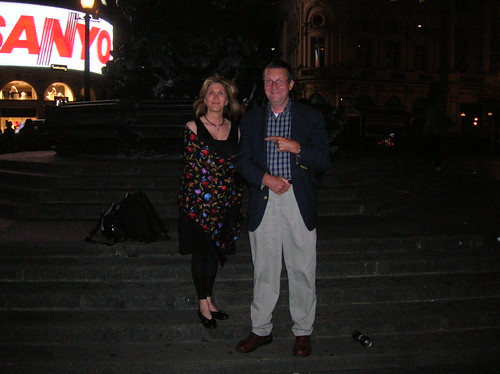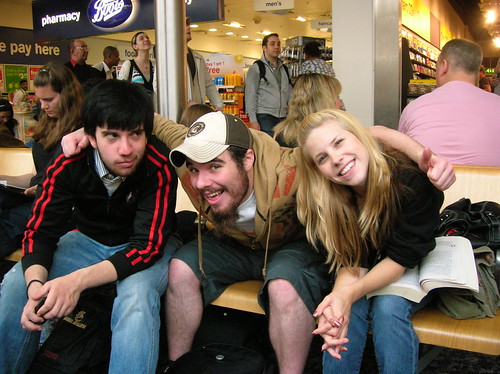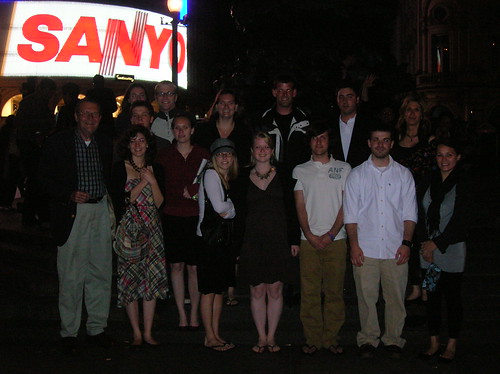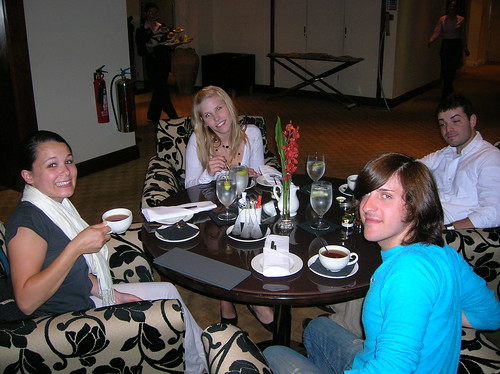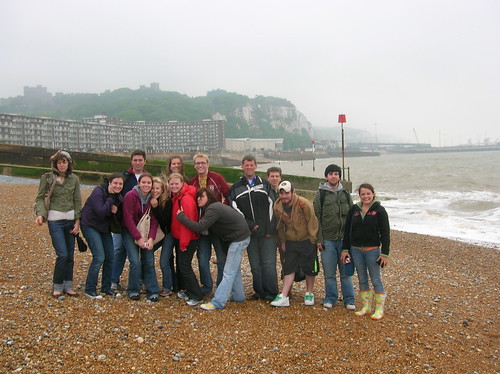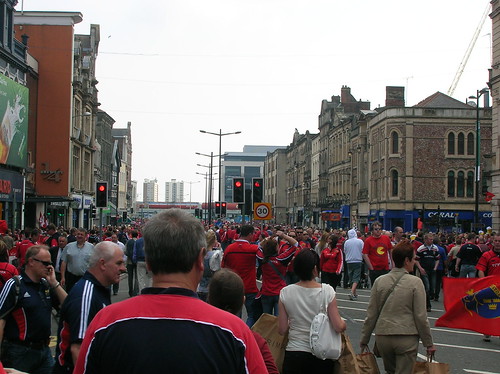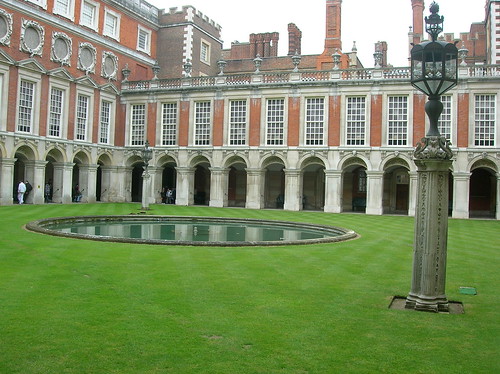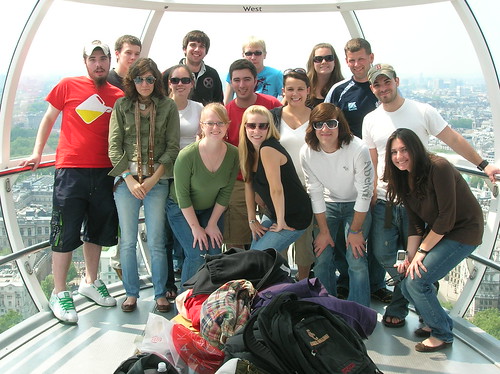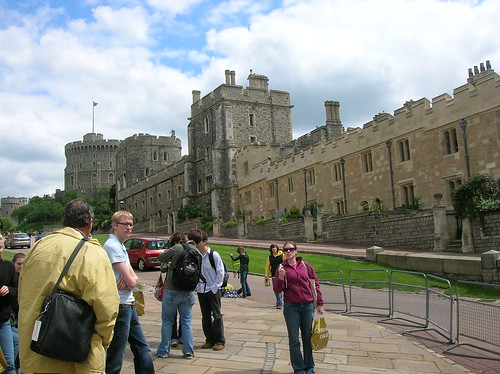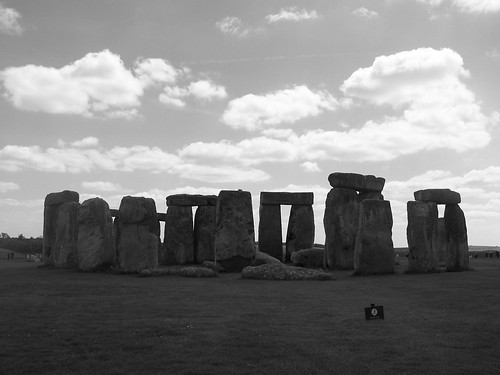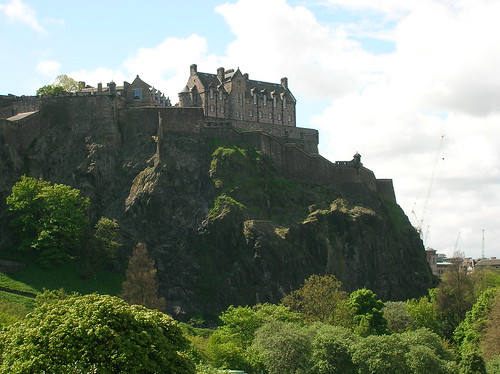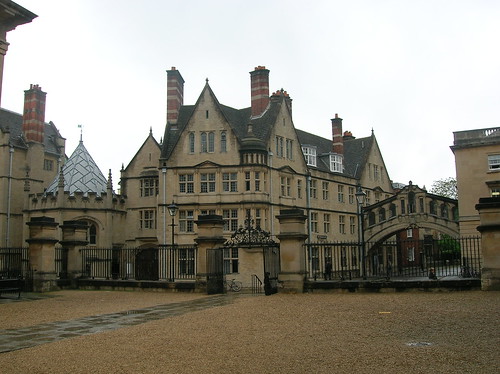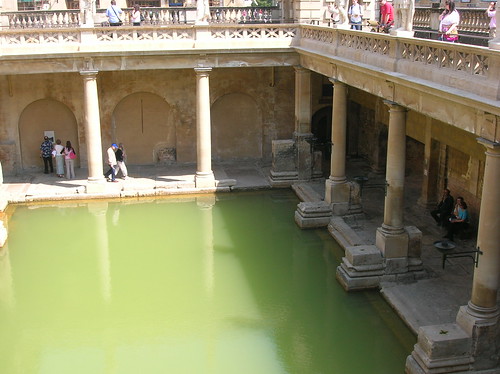Thank you Prof. Wolfe and Prof. Parkhouse. It was a great trip. We'll never forget it.
Saturday, May 31, 2008
Friday, May 30, 2008
Well, Wednesday was our last night, and we went out with high society in mind. After an easy day spent packing and preparing for our departure, Prof. Wolfe and Prof. Parkhouse took us to the Topo Gigio Restaurant for some fancy French cuisine. Prawns, chicken and a vegetarian pasta were on the menu, as were crab cakes, breaded goat cheese and tiramisu.
Following dinner we walked into the Piccadily Theater district to watch Noel Coward's play "The Vortex" at the Apollo Theater. The controversy surrounding his play The Vortex (1924), which contains many veiled references to drug abuse and homosexuality, made him an overnight sensation on both sides of the Atlantic. An interesting play, and a play actors find difficult to master. But Felicity Kendal (as Florence Lancaster) and Dan Stevens (as Nicky Lancaster) and Phoebe Nichols (as Helen Saville) were right on. Each executed the emotion and logic of their characters with fruition.
Thus is the end of our trip to the UK. All of us want to extend our gratitude to Prof. Wolfe and Prof. Parkhouse for having a course that is so informative, involved, and exciting. They packed a lot of the United Kingdom into just three weeks while allowing us to get lost and explore the UK for ourselves. Well done! And thank you!!!
Tuesday, May 27, 2008
Our trip to the United Kingdom is quickly drawing to a close. Only Wednesday remains, so we've packed as much as we could into the last two days.
On Monday we went to Dover to see the white cliffs despite heavy rain and strong winds. The cliff face, which reaches up to 350 feet high, owes its striking façade to its composition of chalk (pure white calcium carbonate) accentuated by streaks of black flint. The cliffs spread east and west from the town of Dover in the county of Kent, an ancient and still important English port. The cliffs have great symbolic value for Britain because they face towards Continental Europe across the narrowest part of the English Channel, where invasions have historically threatened and against which the cliffs form a symbolic guard. We made sure to get a couple of group photos in front of the cliffs.
We then made our way to Canterbury to see the very famous Canterbury Cathedral. Canterbury Cathedral is one of the oldest and most famous Christian structures in England. A pivotal moment in the history of Canterbury Cathedral was the murder of Thomas Becket in the north-east transept on Tuesday 29 December 1170 by knights of King Henry II. The king had frequent conflicts with the strong-willed Becket and is said to have exclaimed in frustration, "Who will rid me of this turbulent priest?" The knights took it literally and murdered Becket in his own cathedral. The death echoed throughout England, and soon pilgrims began making pilgrimages to honor the martyred Becket. These pilgrimages inspired Geoffrey Chaucer to write his famous 'Canterbury Tales'.
On Tuesday we stayed close to home and went to the Imperial War Museum. Inside were the relics of every war the British were involved with: Crimean War, Boer War, WWI, WWII, Korean War, Vietnam War, along with numerous other wars. The meseum honored all men of war, including the great general Monty of WWII, a nickname for Bernard Montgomery, 1st Viscount Montgomery of Alamein, Field Marshal Montgomery, who led all allied ground forces during Operation Overlord. There were replicas of the trench warfare of The Great War (WWI). They even took care to include the same smells that infested the original trenches. It was a very repusive smell. For WWII, the museum had a very moving Holocaust exhibit. We couldn't help but walk out of the exhibit feeling very disgusted at the human race. We are capable of some very cruel things.
We also stopped for tea time at a formal restaurant in London. We tried all kinds of black teas, green teas, finger sandwiches, scones, and little finger candies. We walked out extremely stuffed, and we had some good sugar buzzes!
Sunday, May 25, 2008
On Saturday a small group (9 to be exact) of us went on a day trip to Cardiff, the capital of Wales. Its a lovely city just off of the Bristol Channel. Once we arrived by train we went on a relaxing bus tour of the city, hoping to get taste of the history and the people of Wales. We weren't disappointed. We found Cardiff Castle, once an ancient Roman outpost that changed to a Norman castle. In the early 19th century the castle was enlarged and refashioned in an early Gothic Revival style for John Crichton-Stuart, 2nd Marquess of Bute by Henry Holland. But its transformation began in 1868 when 3rd Marquess of Bute commissioned William Burges to undertake a massive rebuilding which turned the castle into a 19th century fantasy of a medieval palace, with a series of rooms that, perhaps, constitute the highest achievement of later Victorian Gothic Revival design. Burges used 22 karat gold to paint the rooms of the transformed castle and added countless carvings and designs to please John Crichton Stuart.
When we left the castle we were hit with a unexpected surprise. Before our arrival the streets were open. There were only a few cars and pedestrians. Now there were 70,000 rugby fans. It just so happened that the Millennium Dome was hosting the 2008 Rugby European Championship between Munster Rugby (Irish) and Toulouse (French). Of the 70,000 there was an estimated 60,000 Irishmen in attendance. Everyone in the group agreed they had never seen anything like it before. There were red jersies, red flags, beating drums, rallying, chanting, and packed pubs everywhere. We meandered, trying to take it all in.
But eventually we had to leave, and we left the Cardiff rail station as Munster fans. They ended up winning 16-13, clinching their second European title in three years. GO MUNSTER!!!!
Friday, May 23, 2008
Hampton Court Palace was on the agenda today. A beautiful place, and the first castle we've seen that is constructed of brick. It is a former royal palace in the London Borough of Richmond upon Thames, south west London, England. Parts of the palace date as far back as the 14th century, but most of the Palace we saw today was the result of Thomas Wolsey, then Archbishop of York and Chief Minister to the King.
Hampton Court Palace was not nearly as lavishly decorated as Windsor Castle, but there were some lovely paintings of King Henry VIII and Elizabeth I. We also saw a little into living in the 14th, 15th and 16th centuries. It was crude compared to today's terms, but all of us could see how well Thomas Wolsey was.
Hampton Court Palace had some beautiful gardens. They were the most beautiful we had seen thus far. The roses and yews and boxwoods were perfectly groomed to create some great scenes. We found ourselves spending more time out walking in the gardens than we did in the Palace.
Thursday, May 22, 2008
We're all beginning to feel the time running out, but that isn't stopping us from having fun. and what a fun three days we've had. On Tuesday we took a trip up to York to see the remnants of William the Concquerers second castle. While there we also saw the Black Swan, the UK's most haunted inn. In York's younger years it was a place filled with anti-Scot sentiment. That was all thanks to William Wallace and his sacking of the city. As an example of this hatred, York had a seventeenth century law allowing citizens one hour each weekend to shoot any Scot they found. Luckily, the law was reversed.
On Wednesday we stayed in London to see St. Paul's Cathedral designed by Christopher Wren, ride the London Eye, and to see the Globe Theater. All of them were a lot of fun to see. St. Paul's is lavishly decorated, just like the other buildings of the nineteenth century, when the UK was the strongest power in the world. Details everywhere. Unfortunately pictures were not allowed, but the official website does have some lovely pictures for everyone to see. Check it out.
At 451 feet, the London Eye was a treat for some and horrible for others. But we all managed to stay together in one piece, and got some great pictures.
Our final stop on was the Globe Theater. It is a replica of Shakespeare's original Globe Theater. Everything, right down to the wooden railings paitned like marble, were as Shakespeare and his contemporaries would have played at. Some of us had such a great time that got tickets to A Midsummer Night's Dream. Being one of Shakespeare's funniest comedies, we found ourselves laughing at everyline.
On Thursday we went to the Wedgewood factory to see the artists of Wedgewood pottery in action. They can do some remarkably detailed work. But the prices were a little too high, so we came away with a few pictures instead.
Monday, May 19, 2008
Today was a special day for everyone. We went to Windsor Castle (a portion is pictured above). Windsor Castle, in Windsor in the English county of Berkshire, is the largest inhabited castle in the world and, dating back to the time of William the Conqueror, is the oldest in continuous occupation. It may be the most famous castle in the world. The castle's floor area is approximately 484,000 square feet. But there was an added treat. Prof. Parkhouse showed us that when a specific flag is flying above the Round Tower (pictured on the far left) the Queen is in residence. And low and behold the flag was soaring! But unfortunately we weren't allowed to take any pictures. Nevertheless, it was a beautiful place. Full suits of armor, gigantic paintings of the royal family, swords, guns, the Queen's doll house, statues and busts, Windsor Castle was lavish. We all agreed that we had never seen so much gold painted and fixed to the ceilings and walls. It was great.
Sunday, May 18, 2008
The same weekend some of the students went Edinburgh others went to see Stonehenge, including Tori, Marie, Erica, Ken, Kati, Jon, Erin, Ben and Prof. Wolfe. One of the most famous prehistoric sites in the world, Stonehenge is composed of earthworks surrounding a circular setting of large standing stones. Archaeologists believe that the standing stones were erected around 2200 BC and the surrounding circular earth bank and ditch, which constitute the earliest phase of the monument, have been dated to about 3100 BC.
After the long day at Oxford University on Thursday, Prof. Wolfe and Prof. Parkhouse let us have a light day on Friday by taking us to Portobello Street to see all of the local venders sell little bobbins like old wax letter seals, all kinds of jewelry, antique maps, old leather bound books, and even old war metals. Some of us came away with some real bargains. But no matter whether we found bargains or not, all of us were content that we had seen another part of London.
On Saturday three of us set out for Scotland, Edinburgh to be specific. It is a completely different world than London. Different landscape. Different architecture. The Scottish brogue. But much cooler temperatures. Nevertheless we managed to see the beautiful Edinburgh Castle. We also saw the Walter Scott monument, the Royal Museum of Scottish History, a monument to Horatio Nelson, and other numerous statues to local heroes. It was great.
Friday, May 16, 2008
After the hour trip up to Bath on Tuesday, our coordinators Prof. Wolfe and Prof. Parkhouse wanted to spend Wednesday in London. We went to the British National Bank to learn more about Britain's monetary system, and to pick up a gold bar worth roughly $188,500. From there we took a boat ride up the River Thames. We spotted Shakespeare's Globe Theater and London Town Hall before hopping off at the Naval University. Built by Sir Christopher Wren, the Naval University was a sight to behold. The wall and ceiling paintings inside the Banquet Hall and Church were remarkably detailed. The ceiling of the Banquet Hall alone took 19 to paint. From there we walked up the street to the London Observatory, which was also designed by Wren. Wren had a vested interest in the observatory. He was an astronomer, and he sought to fill the observatory with giant telescopes, theadolites, and all the small necessities needed to explore the stars.
Thursday was a very special day for several reasons. First, it was the first day of rain since our arrival at Regent's College. For the first 10 days we've had sun and 80+ degree temperatures. Unheard of for this time of the year. Many Londoners say they've never experienced weather like this before. It's been a treat. Second, it was Prof. Parkhouse's 37th birthday. He looks great... And to mark the occasion we went to Oxford University, his alma mater. It is an old, but beautiful place. Castle-like architecture, vast court yards, and wonderful little details could be found everywhere. Because we were with Prof. Parkhouse, we were given the rare honor of eating in the Christ's College Refectory, which has been used as the Great Hall in all of the Harry Potter films. Wonderful!
Wednesday, May 14, 2008
Monday and Tuesday have been very busy for the UK Crew. On Monday we stayed in London. We went to the Churchill War Museum to see the bunker he called home for much of World War II, especially during Hitler's blitzkrieg on London. Then we took a stroll down Parliament Ave to see Westminster Abbey. Unfortunately they did not allow any pictures to be taken, but I can attest to its beauty. Hundreds of graves and memorials have been packed into the Abbey over the course of 1,000 years. And, staying true to the stereotypes of the English nobility, each grave and memorial is elaborately fashioned in gold-flake paint, elaborate sculptures, and Latinaic verse. Some of the names include Charles Darwin, Sir Isaac Newton (the same sculpture from the Da Vinci Code movie), William Shakespeare, Queen Elizabeth I, King Henry III, and Mary Queen of Scots.
After all that we hopped across the street to Parlaiment, where we saw the House of Lords in action (It seems to work much more smoothly than US Congress. The House of Lords debate, Congress jibbers). The Gothic architecture inside is the same as the outside, simply beautiful. But, with good reason, no pictures are allowed inside.
On Tuesday we took the train to Bath, where we saw the ancient Roman Baths still working. The water is highly sulphurous, and comes out of the ground at a steamy 114.8 degrees. Little of the intricacies of the Roman Baths remain. There are no elaborate filigrees or rosettes, and what they have found is only a small glimpse into the beauty of the Roman Baths. Nevertheless, the accomplishment of Romans at Bath attests to their power and influence felt throughout the Mediterranean and Europe.
